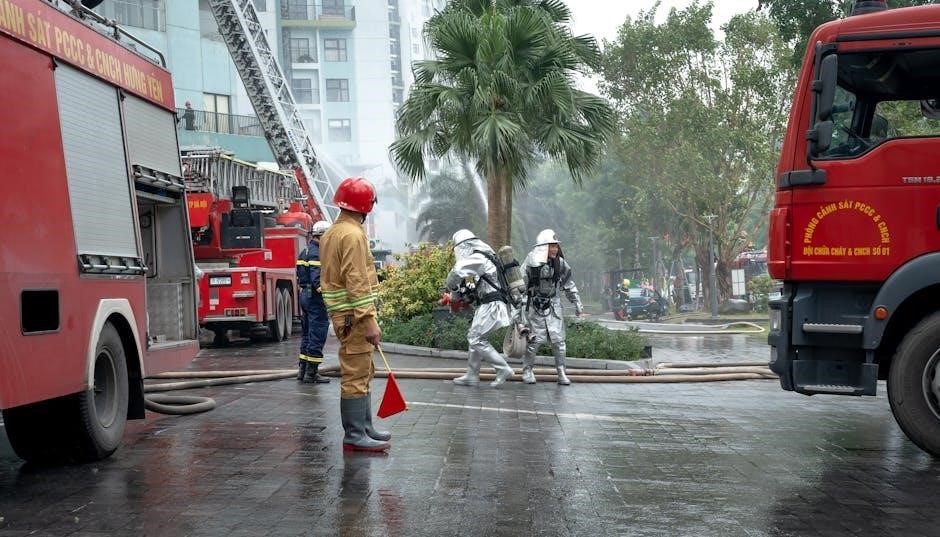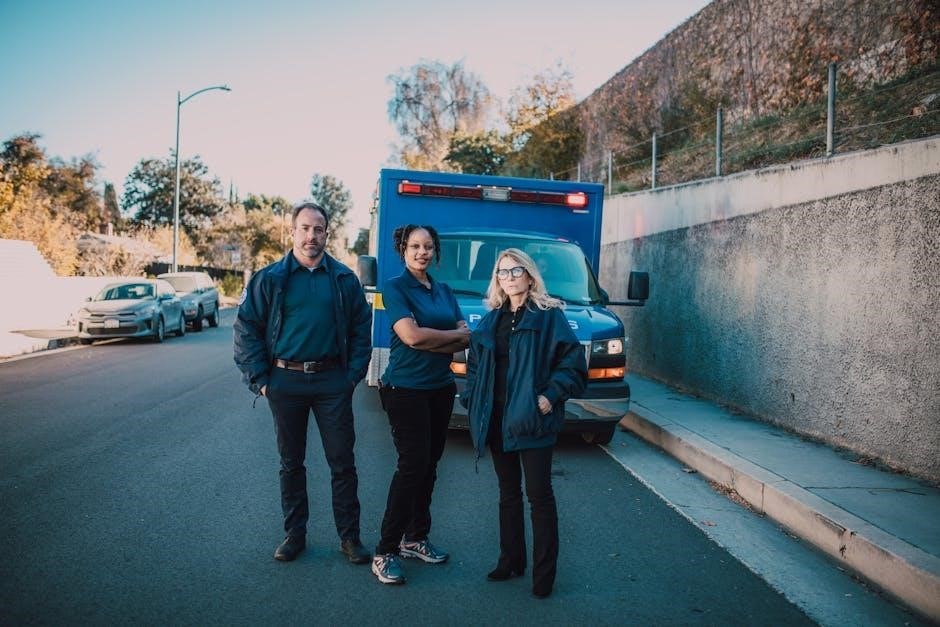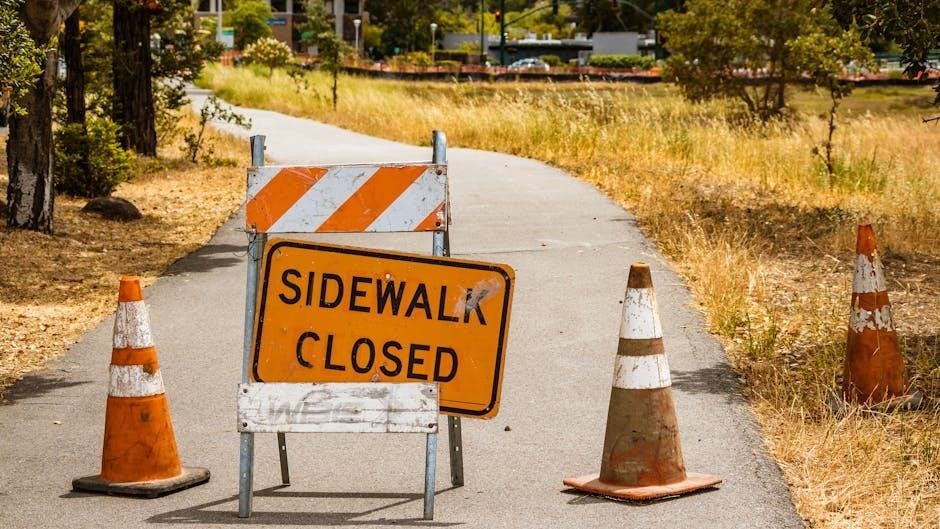Welcome to the First Alert CO400 Manual, your guide to understanding and using the CO400 Carbon Monoxide Alarm effectively. This manual provides essential information on installation, testing, and maintenance to ensure your safety and the proper functioning of the device. Reading this manual carefully is crucial for understanding how to operate and maintain your CO alarm, helping you protect yourself and your household from potential carbon monoxide threats.
1.1 Overview of the CO400 Carbon Monoxide Alarm
The First Alert CO400 is a battery-operated carbon monoxide alarm designed to detect dangerous CO levels in your home. It features an 85 dB alarm horn, a silence button to temporarily quiet false alarms, and a red LED indicator for visual alerts. This device is essential for protecting your family from the risks of carbon monoxide poisoning, offering reliable detection and clear warnings when CO levels rise.
1.2 Importance of Reading the Manual
Reading the First Alert CO400 Manual is crucial for understanding proper installation, operation, and maintenance of your carbon monoxide alarm. It ensures you comprehend safety features, like the silence button and LED indicators, and know how to respond during an alarm. The manual also provides warranty details, troubleshooting tips, and essential safety information to protect your household from CO threats effectively.
Installation Guidelines
Proper installation of the First Alert CO400 is essential for accurate CO detection. Follow the step-by-step guide to ensure correct placement, mounting, and setup for reliable performance and safety.
2.1 Choosing the Right Location for the CO400
Place the First Alert CO400 outside each sleeping area and on every level of your home. For hallways over 40 feet, install alarms at both ends. Avoid areas near vents, direct sunlight, or bathrooms. Central locations ensure optimal detection and compliance with NFPA recommendations for comprehensive carbon monoxide monitoring and safety.
2.2 Tools and Materials Needed for Installation
Install the First Alert CO400 using a pencil, drill with a 3/16″ or 5mm bit, flathead screwdriver, and hammer. Ensure you have fresh AA batteries and the included mounting hardware. Labels for emergency contacts should be placed near the alarm and in your fresh air meeting spot for quick reference during an alarm event.
2.3 Step-by-Step Installation Instructions
Choose a location for the CO400 as per recommendations. 2. Mark the wall with a pencil for drilling. 3. Drill holes using a 3/16″ bit and insert wall anchors. 4. Mount the bracket with a screwdriver. 5. Place the alarm on the bracket and secure it. 6. Test the alarm to ensure proper function. 7. Verify all labels are correctly placed for emergency reference.

Testing and Maintenance
Test the CO400 by pressing the Test/Silence button to ensure the alarm sounds and the LED flashes. Regularly clean the grill with a soft brush and replace batteries as needed. Replace the unit every 7 years or when malfunction signals occur.
3.1 How to Test the CO400 Alarm
Press and hold the Test/Silence button until the horn sounds with a pattern of four beeps, pauses, and repeats. The LED should flash red in sync. Ensure fresh batteries are installed correctly. If no sound or light, replace the unit. Regular testing ensures functionality and safety, maintaining reliability against carbon monoxide threats.
3.2 Understanding the Silence Feature
The Silence Feature on the CO400 temporarily quiets the alarm horn. Press and hold the Test/Silence button until the horn stops. This feature is ideal for addressing false alarms or low-battery warnings. Note that silencing does not disable the CO detection; the alarm will resume if dangerous CO levels persist. Use this feature responsibly to avoid ignoring potential threats.
3.3 Regular Maintenance Tips
Regular maintenance ensures the CO400 operates effectively. Clean the alarm with a soft brush or vacuum to remove dust. Avoid exposure to chemicals or paint. Replace batteries annually or when the low-battery warning sounds. Test the alarm monthly using the Test/Silence button. Never disable the alarm permanently. Ensure proper ventilation when using cleaning products near the device.

Troubleshooting Common Issues
This section helps identify and resolve common problems with the CO400. Issues like alarm chirping, non-response to CO, or malfunction signals are addressed with practical solutions.
4.1 Alarm Chirping or Beeping
The CO400 alarm chirps or beeps to signal issues like low battery or malfunction. A low battery warning chirps once a minute, while a red light flashes. Pressing the Test/Silence button temporarily quiets the low battery chirp for up to 8 hours. However, replace batteries promptly to ensure protection. If the alarm chirps three times quickly, it indicates a malfunction, requiring immediate replacement of the unit.
4.2 Alarm Not Responding to CO
If the CO400 alarm fails to respond to carbon monoxide, ensure proper installation and check for blockages. Clean the sensor with a soft brush or vacuum to remove dust. Verify placement, as alarms may not detect CO if installed too far from potential sources. If issues persist, replace the unit, as sensors degrade over time and may lose sensitivity to CO levels.
4.3 Malfunction Signals and Solutions
The CO400 signals a malfunction with three quick red light flashes and three short chirps. This indicates the alarm needs replacement. If the alarm malfunctions, do not ignore it, as it will not detect CO properly. Replace the unit immediately to ensure safety. Always follow proper disposal and installation steps when replacing the alarm.
Safety Precautions and Tips
Understand CO risks, recognize poisoning symptoms, and ensure proper alarm installation. Keep fuel-burning appliances well-ventilated and avoid running engines in enclosed spaces to prevent CO buildup.
5.1 Understanding Carbon Monoxide Risks
Carbon monoxide (CO) is a silent, odorless, and invisible gas produced by incomplete combustion of fossil fuels. Common sources include faulty heating systems, generators, and improperly ventilated appliances. CO is undetectable without an alarm, making it highly dangerous. In energy-efficient homes, CO can accumulate quickly due to airtight construction, posing severe health risks if not detected promptly.
5.2 Symptoms of CO Poisoning
Exposure to carbon monoxide can cause flu-like symptoms, including mild headaches, nausea, vomiting, and fatigue. At higher levels, symptoms progress to medium exposure, such as throbbing headaches, drowsiness, confusion, and rapid heartbeat. Severe exposure leads to extreme symptoms like convulsions, unconsciousness, and even death. Recognizing these signs early is crucial for prompt action to prevent serious harm.
5.3 Preventative Measures Against CO Exposure
To prevent carbon monoxide exposure, ensure proper installation and maintenance of fuel-burning appliances. Install CO alarms on every level of your home and near sleeping areas. Regularly inspect chimneys and vents for blockages. Never use generators or grills indoors. Keep your home well-ventilated, especially in areas with fuel-burning devices. Replace batteries in CO alarms annually and test them monthly to ensure functionality.

Frequently Asked Questions
Find answers to common questions about the CO400, including installation, battery replacement, and troubleshooting. This section provides clear solutions to help you use your alarm effectively.
6.1 Where Should I Install CO Alarms in My Home?
Install CO alarms outside each sleeping area and on every level of your home. Place them centrally or near bedrooms for optimal coverage. For hallways over 40 feet, install alarms at both ends. Ensure alarms are at least 6 feet away from fuel-burning appliances to avoid false alarms. Follow NFPA guidelines for placement to maximize safety and protection.
6.2 How Often Should I Replace the Batteries?
Replace batteries every 6 months or when the low battery warning chirps once a minute. Use standard AA batteries like Energizer E91. Avoid rechargeable batteries, as they may not provide consistent power. Replace batteries promptly to ensure continuous protection. The low battery warning lasts up to 30 days, but immediate replacement is recommended for safety.
6.3 What Does the Red Light Flashing Mean?
The flashing red light on your CO400 indicates different statuses. During testing, it simulates a CO alarm. If CO is detected, it flashes rapidly with an alarm. A low battery is signaled by a slow flash with a chirp. A malfunction is shown by three quick chirps and a red flash. Always refer to the manual for accurate interpretations and actions.

Additional Resources
For more information, download the full PDF manual or visit First Alert’s website. Contact customer support for assistance or find additional guides and tutorials online.

7.1 Downloading the Full PDF Manual
To access the complete guide for your First Alert CO400, visit the official First Alert website or platforms like ManualsLib. The PDF manual includes detailed installation, testing, and maintenance instructions, ensuring you understand your device’s operation. Downloading the manual provides a comprehensive resource for troubleshooting and safety tips, helping you maximize your carbon monoxide alarm’s effectiveness and keep your home safe.
7.2 Contacting First Alert Customer Support
For assistance with your First Alert CO400, visit the official First Alert website or contact their customer support team. You can reach them at (800) 323-9005 or via email at consumer.affairs@brkelectronics.com. Their team is available to help with troubleshooting, maintenance, and general inquiries, ensuring your CO alarm functions correctly and your home remains safe from carbon monoxide threats.
7.3 Finding More Information Online
Additional resources and detailed guides for the First Alert CO400 can be found on trusted websites like ManualsLib and the official First Alert website. Visit these platforms for comprehensive guides, troubleshooting tips, and updated safety information. Use specific search terms like “First Alert CO400 manual” or “CO400 troubleshooting” to find relevant content quickly and ensure accurate results for your device.

Warranty and Product Information
This section provides details on the warranty coverage for the CO400, its product specifications, and compliance with FCC rules to ensure safe and reliable operation of the device.
8.1 Warranty Details for the CO400
The First Alert CO400 is backed by a limited warranty provided by BRK Brands, Inc. The warranty covers parts and labor for defects in materials and workmanship for a specified period. For warranty claims, contact First Alert Customer Support at (800) 323-9005. Improper installation or unauthorized repairs may void the warranty, so ensure all guidelines are followed as per the manual instructions.
8.2 Product Specifications and Compatibility
The First Alert CO400 is a battery-operated carbon monoxide alarm with an 85 dB horn and a silence feature for temporary quieting. It features a permanently installed sensor and is designed for easy installation on walls or ceilings. The unit is compatible with most home security systems and can be used in conjunction with other First Alert alarms for enhanced safety and coverage.
8.3 FCC Rules and Compliance
The First Alert CO400 complies with FCC rules and regulations, ensuring minimal radio frequency interference. It operates in accordance with Part 15 of the FCC standards. For any concerns or issues related to compliance, contact First Alert Consumer Affairs at (800) 323-9005 or visit their official website for further assistance and documentation.

About First Alert
First Alert is a trusted leader in home safety products, offering a wide range of smoke, carbon monoxide, and combination alarms. Their mission is to protect lives and property through innovative safety solutions.
9.1 Company Background and Mission
First Alert is a leading brand in home safety and security products, dedicated to protecting families and properties for over 60 years. Founded with a mission to create innovative, reliable safety solutions, First Alert specializes in smoke alarms, carbon monoxide detectors, and home security systems. Their commitment to excellence ensures peace of mind for millions of households worldwide.
9.2 Other Products and Solutions
First Alert offers a wide range of safety products beyond the CO400, including smoke detectors, home security systems, and combination alarms. Their product line features models like the CO605 and CO615, providing comprehensive protection against fire and carbon monoxide threats. These solutions are designed to integrate seamlessly, offering homeowners advanced safety and peace of mind through reliable technology and user-friendly designs.
9.3 Customer Service and Support Channels
First Alert provides dedicated customer service through multiple channels, including a toll-free hotline at (800) 323-9005 and online support via their official website. Users can access FAQs, troubleshooting guides, and downloadable manuals for the CO400 and other products. Additionally, the website offers resources for warranty information, product registration, and assistance with installation or maintenance concerns, ensuring comprehensive support for all customers.
